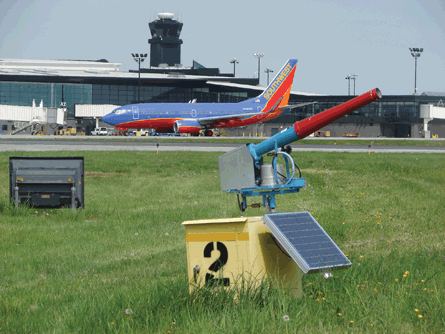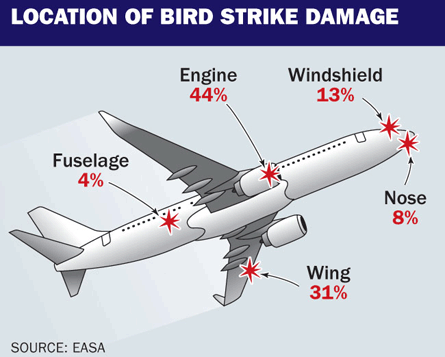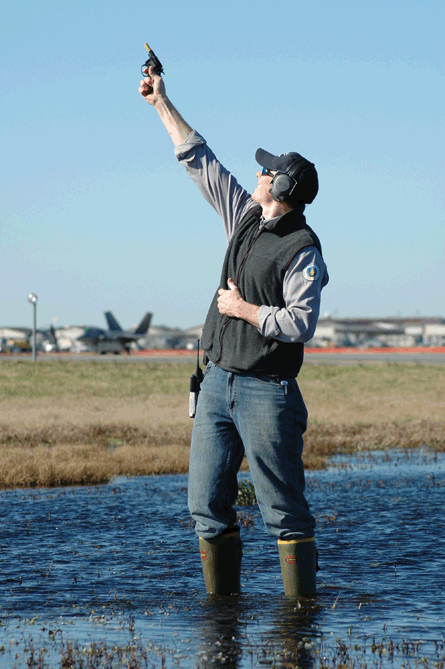Following a loud boom just after an August 2000 take-off from Los Angeles, a KLM Boeing 747 began spewing flames as falling pieces of its Number 3 engine narrowly missed beach-goers below.
The pilot dumped 83t of fuel over the ocean before making an emergency landing. Not until next day could the 449 passengers board another flight, and aircraft repairs totalled $400,000. The cause of all the trouble? A single western gull ingested at take-off.
Birds can pose a hazard not just to an aircraft's engines but to its wings, nose, windshield and fuselage. Most damage can be repaired, but not all: the US Department of Agriculture's (USDA) wildlife service reports that 210 aircraft were totally destroyed by strikes between 1998 and February 2009.
 |
|---|
© US Department of AgricultureAt Baltimore-Washington International airport, propane cannons are fired at fixed intervals to scare birds |
The government/industry Bird Strike Committee USA, of which the USDA is a member, reports that civil aircraft sustained over 9,000 wildlife strikes in 2010, while the US Air Force reported about 5,000. The USDA partners the Federal Aviation Administration in recording, studying and preventing collisions between wildlife and aircraft.
US commercial aviation alone accounts for almost 30 million arrivals and departures annually. As the populations of bird and animal species commonly involved in "wildlife strikes" rise, habitat lost to industrial and residential development increasingly forces wildlife into runways and airspace where they most often are ingested into engines.
What can be done to reduce the risks? A three-pronged plan of action for airports is suggested by Mike Begier, national co-ordinator for the USDA's airport wildlife hazards programme. The first step is ecological and environmental: noting what species reside in the area, and what features of the airport land could attract them. Airports can request wildlife hazard assessments from the USDA.
Commercial airports are required by the FAA to conduct wildlife hazard assessments when "an aircraft experiences a multiple-wildlife strike, an engine ingestion of wildlife, or substantial damage from striking wildlife".
Regulations also require airports must do the assessment if personnel note wildlife have access to any flight pattern or ground area. However, under a notice of proposing rulemaking planned for the third quarter of this year, all commercial service airports will be required to perform an assessment regardless of whether a "triggering event" has occurred.
The FAA mandates implementation of the individualised wildlife hazard management plans that result from assessments.
These plans focus on the control of attractants, including trash, standing water, grasses and shrubs. Mowing grass to the right height is crucial, as is promoting a monoculture instead of diverse vegetation. Begier says that to wildlife, an airport with only one type of grass is like an unappetising salad bar that has only iceberg lettuce.
Selective use of herbicides can eradicate the plants that attract wildlife.
Drainage ponds, an airport necessity, are less appealing to waterfowl if they feature steep, inaccessible sides, a long, narrow shape, and additions like plastic balls or wire grids that crowd the water.
HAZARD ASSESSMENTS
The USDA's wildlife services programme has some level of representation at 70% of certificated US airports, be it through visits to conduct wildlife hazard assessments or full-time on-site airport staff. In 2009, this included 612 civil airports, 120 civil/military joint-use facilities and 90 military bases.
However, it is impossible to keep total control over what attracts wildlife, so techniques to scare or harass wildlife out of the area are required as the second line of defence. Some methods are visual, and some rely on frightening sounds. Common devices include noise-producing propane cannons preset to blast at certain intervals. At Baltimore-Washington International airport, tower staff have digital control of ground cannons when problem birds are spotted.
 |
|---|
Other scare tactics include various pyrotechnics, while visual methods make use shiny Mylar tape and even lasers. However, the risks to pilots' eyes on take-off and landing mean these are often limited to hangars.
Pennsylvania-based ornithologist Rob Fergus - an expert on urban ecology and the interactions between people and birds - elaborates on the difficulties of scaring birds away from airports. The problem with any measure to deter birds, from loud noises to scarecrows, is that birds are intelligent, he says. The advanced social development of large, flocking birds like geese makes them highly adaptable. Begier says that narrow airport drainage ponds make it easier to scare fowl off the water by driving trucks close by, but Fergus drily suggests counting how many parking-lot crows and gulls are deterred by cars once they learn that the vehicles are not a threat.
If environmental or harassment measures fail, the unfortunate last resort is "depredation" or "lethal control". The paramount concern for human safety sometimes requires that firearms are used on-site to kill wildlife that cannot be removed any other way.
Begier's programme lies amid strata of state and federal agencies that deal with specific regulations and permits for harassment, relocation and depredation, particularly for endangered or sensitive species. He emphasises that US wildlife and its habitat are in the public trust: depredation "doesn't happen in a vacuum" because "anyone expects that any work dealing with [the wildlife] is done the right way", through appropriate scientific and governmental agencies.
This helps to prevent incidents like a 1990 event in which several deer were struck on the runway by a Hawker Siddeley aircraft taking off in Tennessee. The aircraft's left engine tore loose from the aircraft upon completely ingesting a deer.
Deer account for about 2% of all wildlife strikes, Begier, and a "no tolerance" policy applies to the species at airports because almost 90% of deer/aircraft collisions result in significant damage, often to sensitive landing gear.
SUNBATHING ALLIGATOR
Other problem species vary by location and include coyotes, elk, moose, and the 3.4m (11ft) sunbathing alligator whose removal from a Carolina runway required a dozen men. Begier and Fergus concede that there is no foolproof method for eradicating wildlife from airports.
However, Begier is optimistic about the success of wildlife hazard management plans in reducing airport wildlife strikes, noting that since these efforts became widespread in the 1980s there has been a downward trend in airport-area birdstrikes at or below 500ft.
The European Aviation Safety Agency reports that low-flying aircraft are at the greatest risk of strikes. Nearly half of birdstrikes worldwide between 1999 and 2008 occurred at take-off and almost a third at approach, so any success in assessing and managing wildlife hazards at airports is significant.
However, there has been no corresponding drop in birdstrikes over 500ft. EASA puts worldwide "en-route" collisions with birds at 15% of total strikes, and Begier admits that the prevention of strikes at higher altitudes is in its infancy, with a near-total lack of official procedures for pilots who encounter birds in the air.
Migrating flocks pose the greatest risk, says Fergus, and there is little that can be done except study their habits and learn to avoid them. Studies on avian physiology suggest that certain wavelengths of light deter birds, activating the same need to flee that an encounter with a predator would.
Although the effectiveness of this would vary with atmospheric conditions and also with different species, this knowledge could inform design of aircraft lights that help keep birds away.
 |
|---|
© USAFA US Department of Agriculture worker disperses birds at Langley AFB |
Fergus advises that some collisions will always be inevitable, as no bird in the path of an aircraft has the speed to escape.
Radar can offer a wealth of information on bird hazards and, although it often lacks the crucial ability to determine what species is approaching, technological advances are beginning to allow radar analysis of individual wing-beats which will help to distinguish different species.
Many birdstrikes mean little more than a sudden landing and, in the case of a 1998 vulture strike over Texas, the smell of "freshly baked bird" in the cockpit.
Generally, wildlife strikes pose less of a threat than pilot error, Fergus insists.
However, the risks are real, and the growing use of wildlife hazard assessments and their resulting management plans indicate that the best solutions rely on our ability to adapt to the biology and behaviour of the ones who were flying long before we were.
HOW FEATHER CLUES CAN SAVE LIVES
The feathers were all over," says Mike Begier, national co-ordinator for the US Department of Agriculture's airport wildlife hazards programme. The biologist had been called on by the investigating National Transportation Safety Board to help identify the birds that caused the "miracle on the Hudson" ditching of US Airways flight 1549 in January 2009.
When Begier examined them, the engines of the Airbus A320 were full of feathers and tissue. It was eventually determined that several Canada geese caused the crash, with at least two ingested into one engine and at least one into the other. The end results even determined the sex of the ingested birds, and that they had been migratory rather than local.
 |
|---|
© NTSBFeathers can reveal the birds' species, age and sex |
Samples like the ones Begier collected from the Hudson-doused engines have only just begun a scientific journey. When bird remains are recovered from inside jet engines, the offending species is not clear. Sometimes whole feathers or even body parts can be recovered, but other times proof of the strike is little more than a dent with a smear of blood or tissue - evidence called "snarge". These samples arrive at the Feather Identification Lab at Washington DC's Smithsonian Institution, where biologists determine the remains' species. With the world's third-largest collection of bird remains on-site, the first step to identifying recognisable remains is a visual comparison. The second identification tool is microscopic examination of feathers, which cannot always determine exact species but can pinpoint a type of bird. Finally, when needed, available DNA evidence can be used to say exactly what species was involved.
BIRDSTRIKE REPORTS
It might seem strange that such an exhaustive method is necessary to find out what bird struck an aircraft, but beyond the fact that many remains are unrecognisable without microscopes, the appearance of intact feathers within one species can also vary with the time of year and the bird's age and sex.
The Federal Aviation Administration urges that designated forms be used to report all birdstrikes, and the Feather Identification Lab offers specific guidelines for the collection and mailing of remains.
The airport wildlife hazards programme is working to increase proper strike reporting by simplifying the collection process.
Begier displays a prototype of a "universal bird strike collection kit". It looks a little like a DVD case, but in addition to an instructional DVD contains sterile gloves, the FAA wildlife strike form and "DNA cards" designed to hold swabs of blood or tissue when feathers are unavailable. As there is no 100% effective method of keeping birds away from aircraft, it is crucial to learn as much as possible from each incident to prevent future strikes by anticipating birds' behaviours and movements. Knowing the bird's species provides a wealth of information on its range, diet, migrations and habits.
Source: Flight International



















